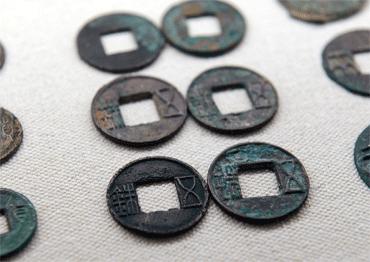Devaluations like these were the main causes of inflation in ancient China. But why did emperors keep using devaluation if it created more problems than it solved?
In ancient China, copper was the primary material used to mint coins. As China was rich in the metal, there were no shortages to constrain government creation of inflation. In contrast, regions such as Europe used rare gold and silver for coins, which put natural limitations on the government’s minting activities.
However, rarity did not affect the supply of gold or silver coins in Europe. In his book The Power of Gold: The History of an Obsession, American financial historian Peter L. Bernstein writes that limited gold and silver reserves do not cause coin shortages.
Chinese economist Qian Jiaju and monetary historian Guo Yangang studied the records of the Western Han and Xin dynasties between 202 BCE-23 CE. In their book published in 2005, they concluded that gold and silver were not in short supply in China during that period.
Chinese monetary historian Peng Xinwei has compared the gold reserves of China during the Han Dynasty and the Roman Empire. In his book published in 1958, he noted that the gold reserves of the Roman Empire were less than that of China during the Han.
Peng concluded it was not rarity of minting material but minting itself that caused inflation in ancient China.
Ancient Chinese currencies were fiat, a legal tender whose value is backed by the issuing government, not the material used to mint it. In ancient China, the monarch was at the core of the State. Guanzi, an ancient Chinese political and philosophical text from the 7th century BCE named after its author Guan Zhong, clearly defined currency minted under the reigning monarch as a tool for the State to “control properties, cover civil affairs and thus govern the country.” The book specifies how to adjust the prices of goods, mainly food, in a way similar to today’s inflation and deflation through money supply. Later dynasties adopted these principles, showing how imperial governments sought to solve financial crises by increasing money supply.
According to economic historian Liu Zhiwei at Sun Yat-sen University, ancient Chinese people’s views on wealth revolved around food and goods. So historical records of economic affairs were often titled “records of food and commodities.” The food and commodities chapter of the Book of Han defines wealth as “natural endowments from heaven and earth,” and the issue was how to gain, possess and distribute them. Emperors were supposed to control the distribution of wealth. Different from modern market economics, which refers to the creation of wealth through division of labor and allocation of resources, supreme imperial power and institutional arrangements made excessive inflation tax possible in ancient China.
But today, fiat currency depends on the credit of the issuing government, which keeps its money stable. Hyperinflation occurs when the issuing government is not able or willing to stabilize its money. This is the actual difference between ancient Chinese copper coins and fiat money, whether in gold, silver or paper. It is not about the materials used, but the lack of faith in a legal tender.
The measures one economy takes to deal with inflation can affect other economies around the world. The Fed is expected to raise interest rates more than once in 2022 to control inflation. If so, it will attract more global capital flow to the US. This will make it difficult for other economies, including China, to further relax their monetary policies to boost growth. China’s central bank, the People’s Bank of China, has pledged to continue to pursue “a sound monetary policy that is flexible and appropriate.”

 Old Version
Old Version
